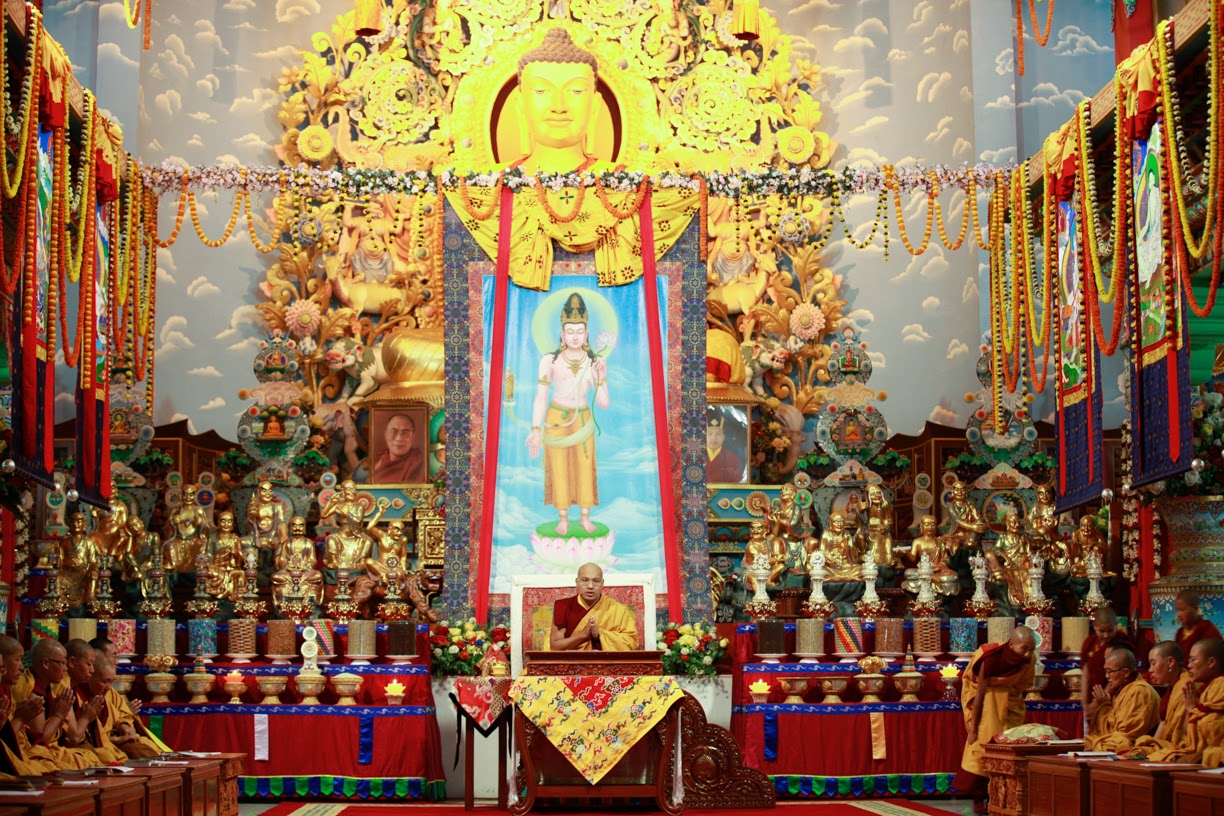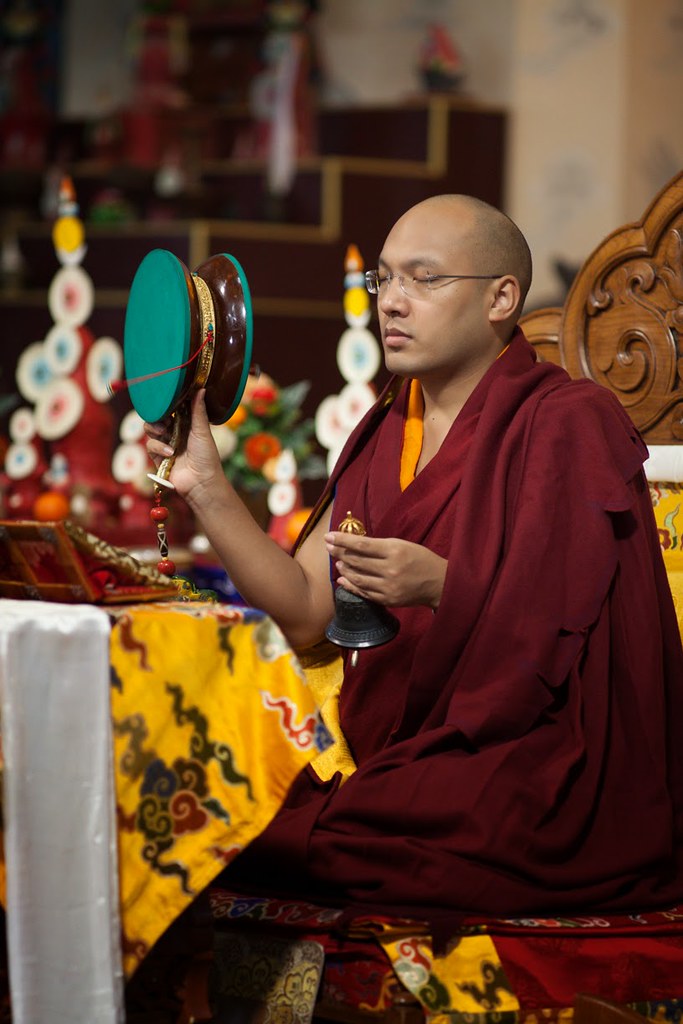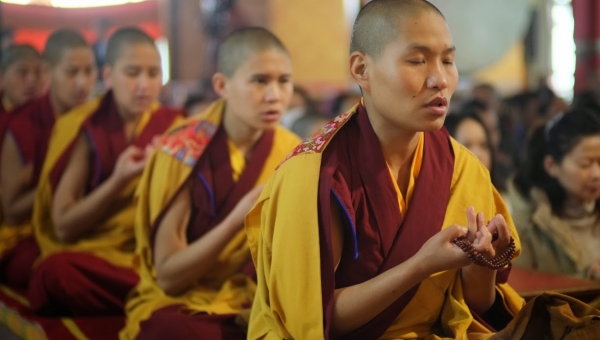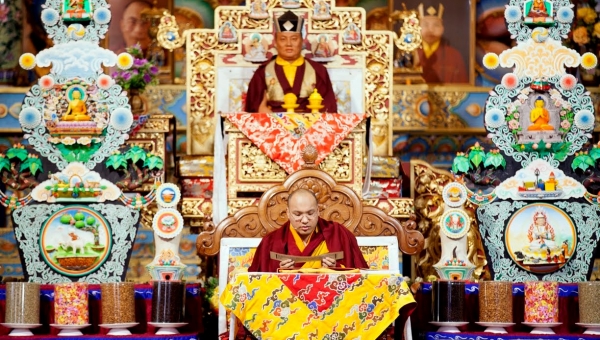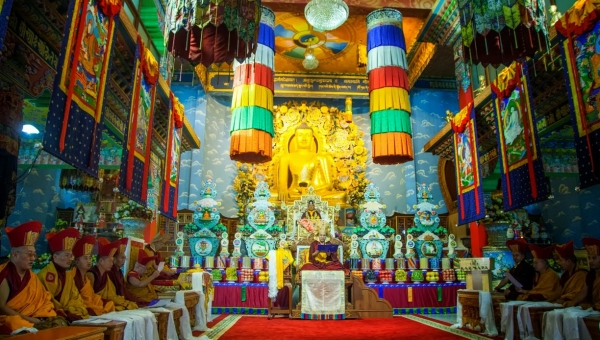The main shrine hall of Tergar Monastery had been transformed for this the first ever Karma Kamtsang Nuns’ Winter Dharma Gathering. The great tormas from the Kagyu Monlam had been brought over from the pavilion and, along with offerings of fruit, biscuits and sweets, intricately arranged into cylindrical shapes Korean style, they adorned the front of the dais behind the Gyalwang Karmapa’s throne.
The magnificent, brightly-coloured stitched thangkas of the Kagyu forefathers and lineage holders, which had lined the sides of the Monlam Pavilion aisle, now hung on either side of the central section of the shrine room. The 197 nuns, drawn from 6 Karma Kagyu nunneries in Bhutan, India and Nepal, along with a scattering of Chinese and Western nuns who follow the Tibetan Buddhist tradition, sat patiently in rows of raised seats, and a nun umze waited to lead the chanting.
The Gyalwang Karmapa has several times expressed his intention to raise the educational standards of nuns and make the three trainings available to them.
As he said in a video released a few weeks ago,
The times have changed and we are now in an age in this world when it is important that women are equal and that everyone is given the same educational opportunities. So in this time, we must take this opportunity. I think it will be extremely good to give nuns all of the facilities for studying, contemplating, and meditating.
The Winter Debate session for Karma Kamtsang monks has been running for seventeen years but this is the very first time when the nuns of the Karma Kamtsang have been called together at the behest of the Gyalwang Karmapa. He has chosen to call it the Arya Kshema after the nun of the same name who was the foremost of the Buddha’s female disciples, the wisest of the wise and the most confident, as a cause for the nuns to become better educated and more confident.
Because the new programme of studies for nuns, which will raise their educational level to that of the monks, is in its preliminary stages, there will not be extensive debating this year. Instead, Khenpos will hold twice-daily classes in order to teach the nuns the fundamentals of debate, based on a text on Collected Topics. In addition, as is the case during the monks’ winter debate session, the Gyalwang Karmapa will give an extensive ten-day teaching. This year he has chosen Gampopa’s Jewel Ornament of Liberation.
After initial prayers, Ngodup Pelzom, older sister of the Gyalwang Karmapa, opened the speeches which would set the tone for the conference. She talked as “a woman talking about women’s issues“. Though half of the world’s 7 billion population was female, and women often formed the majority in religious activities, women still faced many difficulties because of their lower status within society. She shared her own experience of prejudice, growing up as a nomad girl in Tibet. When her father taught her to read, his fellow villagers had criticized him, saying that there was no point educating a girl as she just needed to know how to tend the yaks and goats, how to cook, look after children and so forth. Hearing this, many of the Tibetan nuns in the audience cried; being undervalued and dismissed, and having to battle for an education were obviously experiences they shared.
Pelzom la highlighted two requirements: to change how society views women and to educate women thus increasing their confidence so that they would not become discouraged. Without education women could neither fulfill their own personal wishes nor could they gain status in the eyes of the wider society. Nuns require the same facilities and opportunities – shedras and retreat centres— as monks, she said. In terms of the Buddhist teachings they needed to study ethical discipline, meditative stabilisation and wisdom, and though they have not yet received gelongma vows, in future that would happen too. It was essential that nuns received all of these facilities in order to fully support the Buddha’s teachings. Because of the great kindness and under the guidance of the Gyalwang Karmapa, nuns would now receive the chance to study as monks. However, this brought new responsibilities. In the past they could complain that they didn’t have the same opportunities, but, now they would not have this excuse so it was important that they had the courage to seize the opportunities. The future is in their hands.
The next speaker was an American nun, the Ven. Lhundup Damchoe. Illustrating the Buddha’s own regard for nuns, and his intention that they should hold an equal place in preserving the Dharma, she recounted the story from Sanghabhedavastu (dge ‘dun byen gyi gzhi) of how “Mara came and suggested that the Buddha should pass into parinirvana since he had already accomplished his aim of attaining complete enlightenment. The Buddha replied that he would only pass into parinirvana after not only his bhikshus but also his bhikshunis and upsakas had a clear understanding of the Dharma and could successfully debate with those who argue against the Dharma.” The Gyalwang Karmapa was now making this opportunity available to the Karma Kamtsang nuns. However, there seemed two major obstacles: the outer one is lack of material and educational opportunities, and the inner one which is the nuns’ lack of confidence in them.
She continued by explaining many people didn’t realize that gender equality is a recent phenomenon in the West, and spoke of the problems her own mother had encountered. It was important to understand that ideas about gender roles are simply ideas, not truths, and women often allowed such ideas to put limitations on their achievements. Furthermore, the 21st century world desperately needed the Dharma and female qualities of caring and compassion.
Ani Damchö concluded with a plea to the nuns to “deepen your Dharma understanding and practice, and accept the responsibility of helping to keep the teachings of Buddha alive and available around the world”. [Opening Speech by Ani Damchö]
The third speaker was the Ven. Miaorong Fashi, a Taiwanese nun. She spoke on the qualities of female wisdom and courage as she had experienced them, especially living and interacting with Himalayan women. “Being a Buddhist disciple,” she said, “we all know that wisdom, courage and compassion, all these wonderful qualities are inherently owned by all sentient beings. The only difference may be in the expression and demonstration of these qualities.” But women in particular display qualities of “tenderness, humility and gentleness, and delicacy, as well as great perseverance, self-sacrifice, and forbearance”. Nuns now had the responsibility to “fundamentally transform the ideas held by the whole of society and the ideas and understanding which we hold of ourselves”. [Opening Speech by Ani Miaorong Fashi]
The fourth speaker was Khenpo Kelsang Nyima, the senior Khenpo at Rumtek shedra. He placed the Arya Kshema gathering in the wider context of the work which the Gyalwang Karmapa, the embodiment Buddha activity, has been undertaking for the benefit of sentient beings. First His Holiness had ensured that the heart of the Kagyu teachings, the 13 Tantras of Marpa, were preserved and protected. Then he had restructured the Kagyu Monlam, restoring codes of conduct for the Kagyu sangha, producing a new book of prayers, composing beautiful new melodies, commissioning new and splendid tormas, so that the Kagyu Monlam had become something to be admired and honoured. The Karmapa was making sure that practitioners received the empowerments, oral transmissions and key instructions that they needed in order to practice the specific Kagyu lineage practices. He had also produced plays of the Life of Milarepaand Karma Pakshi and organized the celebration of Karmapa 900. He had encouraged people to complete their preliminary practices and retreats, and he had enhanced the quality of debate in the monks’ gunchoe by introducing external judges and prizes.
Now, His Holiness had organized the Arya Kshema Winter Gathering for Nuns. This had not been at the request of the nunneries or monasteries but was part of the Karmapa’s vision for the future of the Karma Kamtsang, and reflected his continuing support of nuns, including his contribution to the debate on the gelongma issue.
The next speaker, Khenpo Tsultrim Namdak Rinpoche Principal of Sherab Ling Shedra, emphasized the importance of education. The Arya Kshema Winter Dharma Gathering, as well as being a great new hope for the education and conditions of nuns, would be a vast and beneficial activity because it came from the creative vision of the Gyalwang Karmapa. The 21stcentury is an age of education but the Karma Kamtsang had fallen behind the Gelugpa. Gelugpa nunneries already had full educational programmes in place: they held an annual debate competition between nunneries, and were soon to produce the first Geshema from their shedras. The teachings of the Buddha are vast and profound and Buddhism as a religion depends on wisdom and intelligence. It is very difficult to practice and study the Dharma without an education. Through education, we increase reasoning and logic. Traditionally in Tibetan history, many women played an important role, becoming scholars or great practitioners, and these days, many powerful countries have women leaders. Indeed, it’s a Bhikshuni who leads the largest charitable organisation in Taiwan.
The penultimate speaker was Goshir Gyaltsab Rinpoche who emphasized that all sentient beings have buddha potential. There is no difference between men and women, he maintained, in vows, realisations, attainment, or practices. There are male and female bodhisattvas and yidam deities. Women have attained Arhatship. He then gave examples of many famous women practitioners who had benefited the Dharma and sentient beings: Yeshe Tsogyal assisted Guru Rinpoche when he concealed his treasures; Dagma, Marpa’s wife, gave empowerments; Machig Labdron began the Chöd tradition, and she was an important disciple of the 9thKarmapa; the 16th Karmapa received transmissions and teachings from Shugseb Jetsunma, who entered the state of thugdam when she died. Rinpoche reassured the nuns that this great opportunity for them to study would, likewise, be of immense benefit to sentient beings.
His Holiness the Gyalwang Karmapa’s speech concluded the opening ceremony. Time was running out, he said, and he felt that most of what he had to say had already been said, so he spoke briefly of the need for all four pillars of the teachings, the four communities of male and female, ordained and lay practitioners, to exist in order for the Buddha’s teachings to flourish and survive. The Buddha himself gave the order for the ordination of women and established the female sangha [Tib. Gelongma] so the Tibetan tradition was at fault for letting things slip. Consequently, Tibet could not be counted as a ‘central land’. As had been mentioned already, women formed half the world’s population , and there were many female followers, so it was very important to support and care for their practice.
Gyalwang Karmapa expressed his belief that this was an auspicious moment: the first Arya Kshema Winter Dharma Gathering for Nuns, and a fortunate opportunity. He prayed that this dharma gathering would continue forever, serving the good of not just the Buddhist teachings in general, but also the nuns in particular. He spoke movingly of his mother in Tibet. Even though, naturally, he was fond of both his parents, he admitted missing his mother more. They were now separated by a huge distance but he felt that to serve and benefit nuns and laywomen was a way in which he could continue to symbolically serve his mother and his sisters. He admitted that in recent years many problems had arisen for him personally, both internal and external, such as had never arisen in the lives of previous Karmapas. This had led to moments when he had experienced both disappointment and discouragement, but still he held the hope that he would be able to serve the Dharma and work for the benefit of nuns and all beings for the rest of his life.
Finally, he said, everyone should appreciate the auspiciousness of the conditions. This gathering at the sacred site of Bodhgaya, with Rinpoches, Tulkus, Khenpos, nuns and laypeople was the fruit of great merit, the result of the compassionate blessings of the buddhas, the arhats and the bodhisattvas.


















